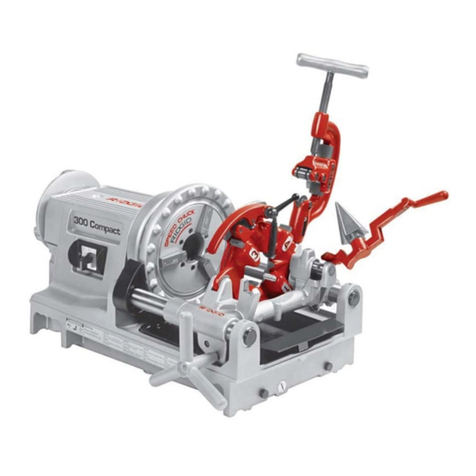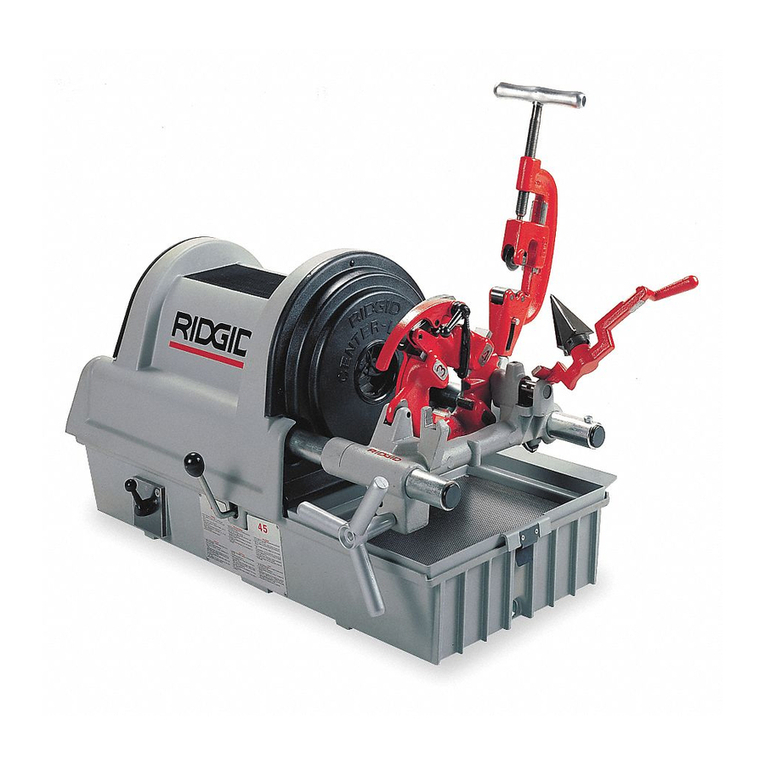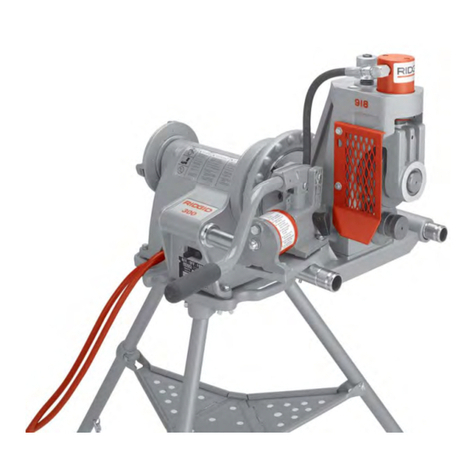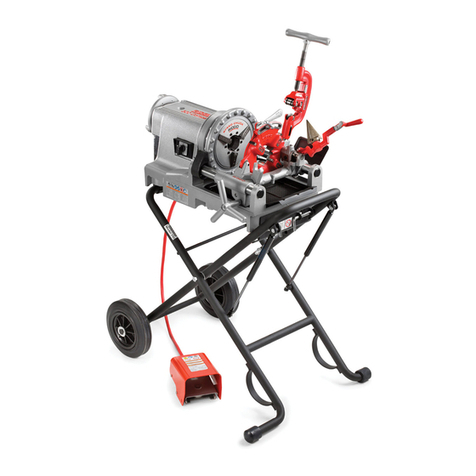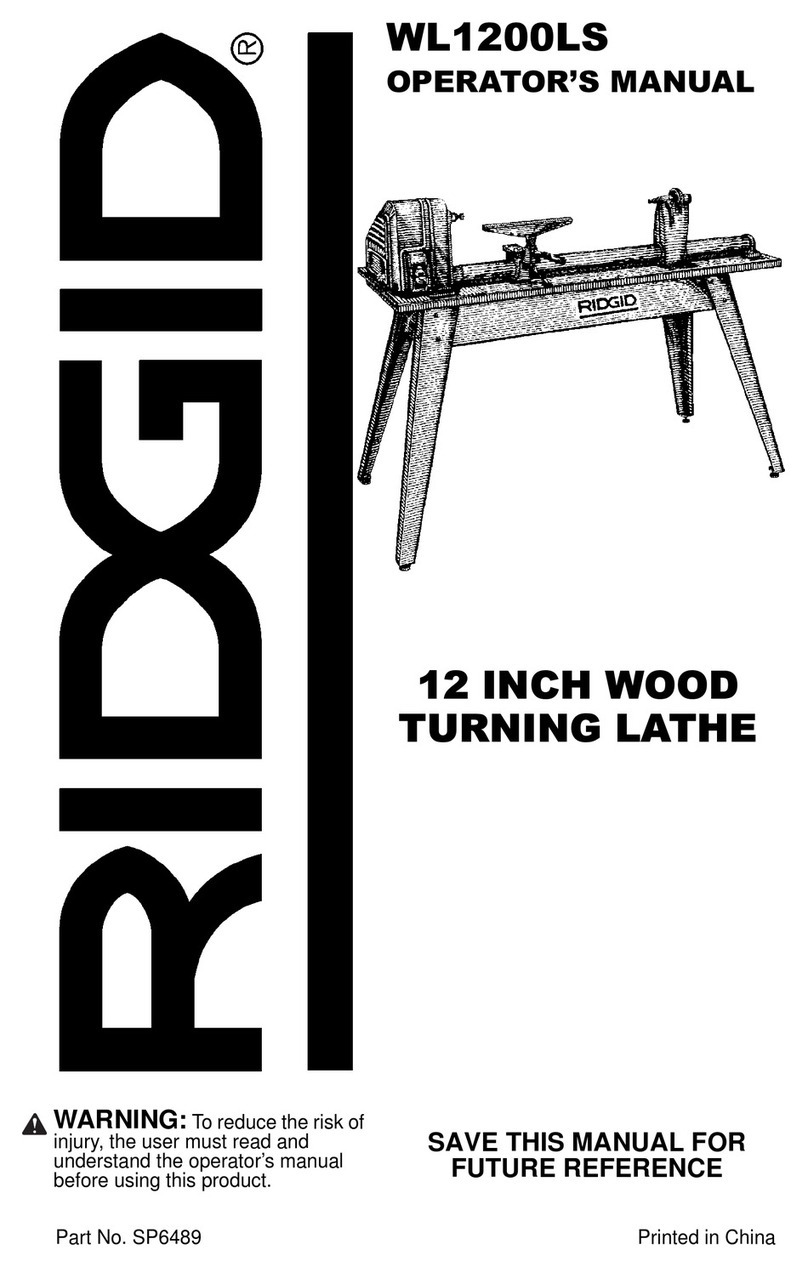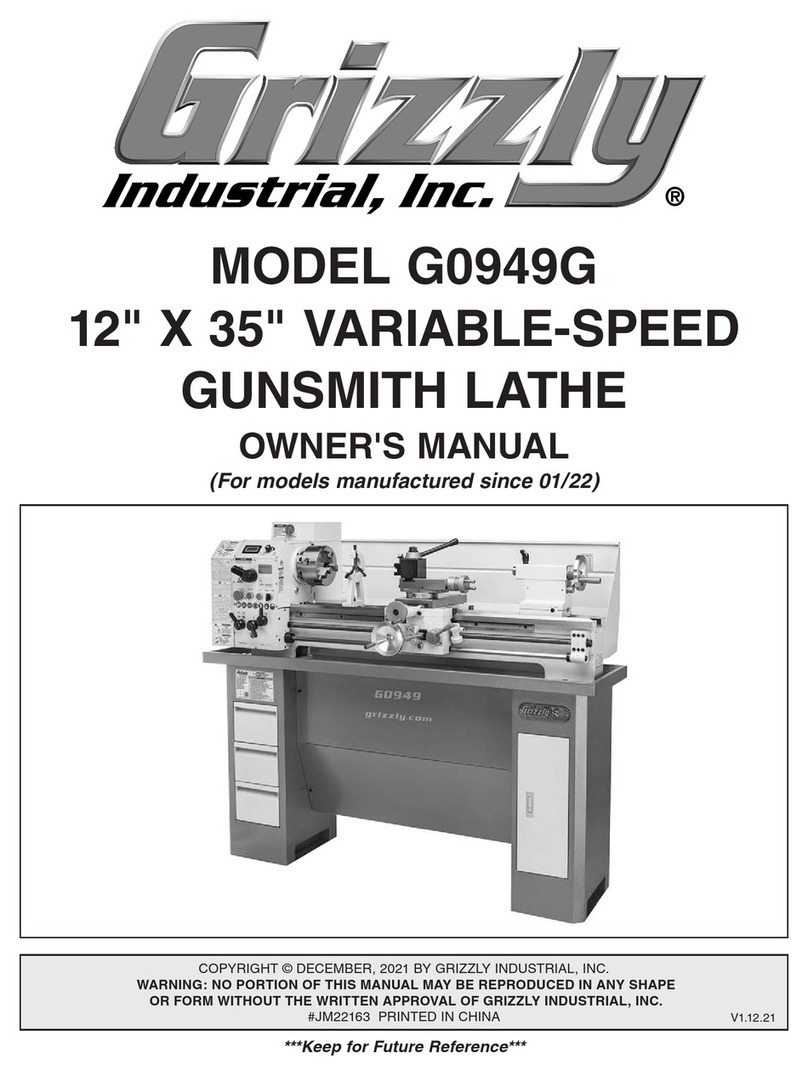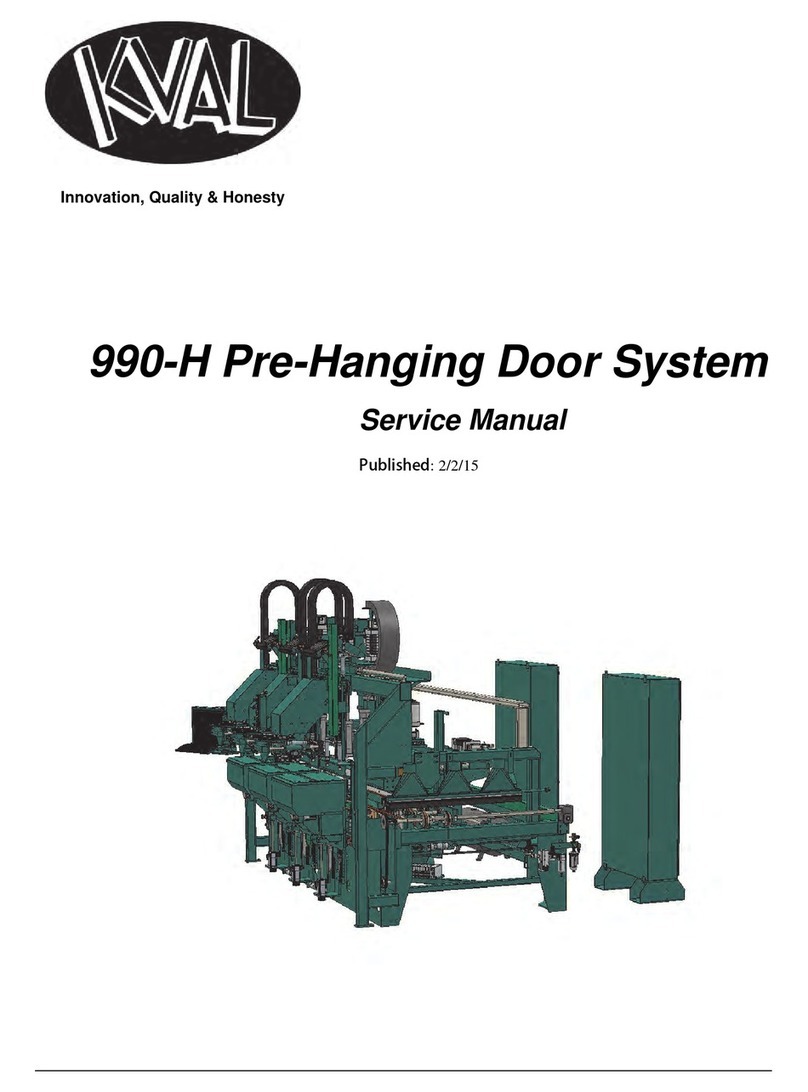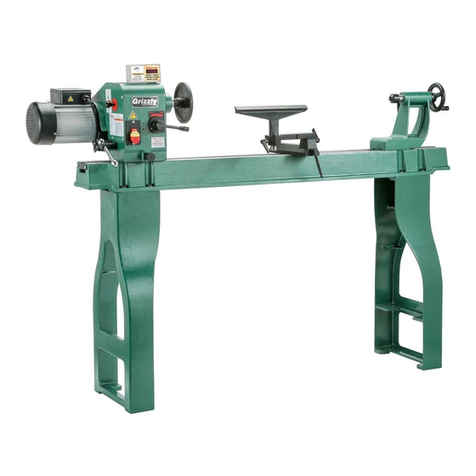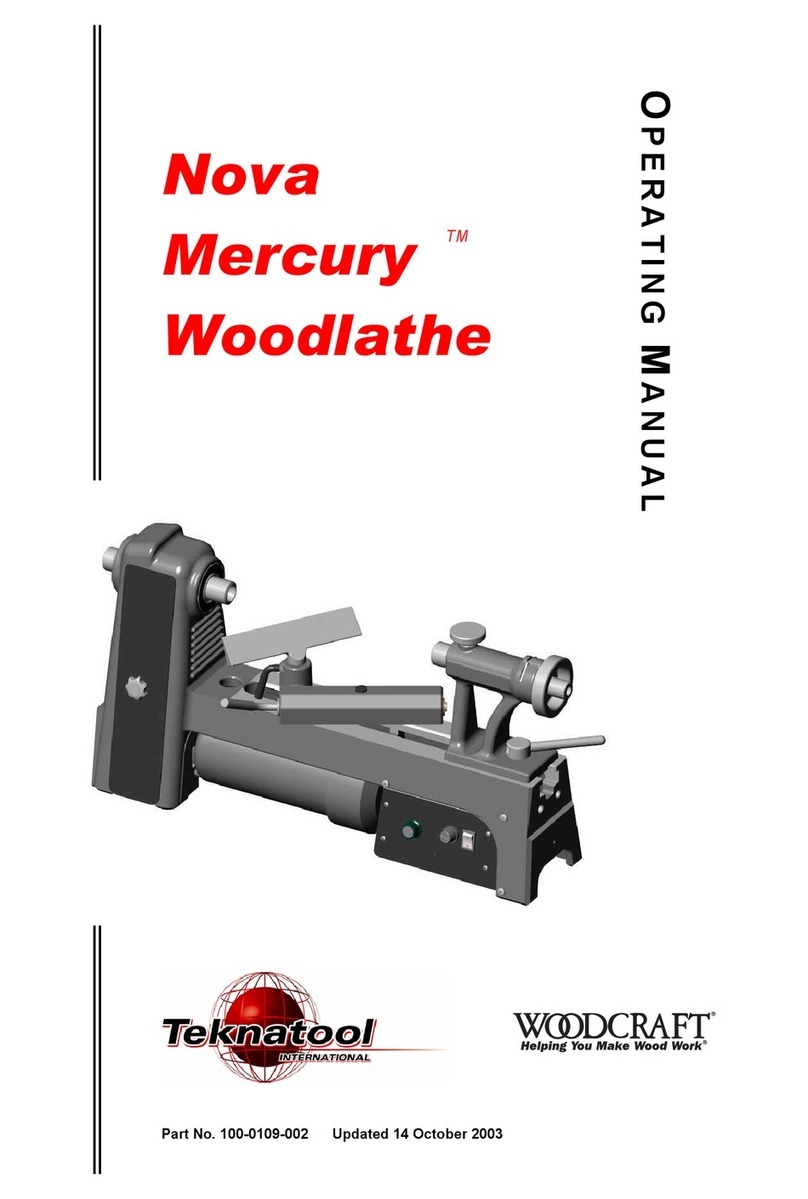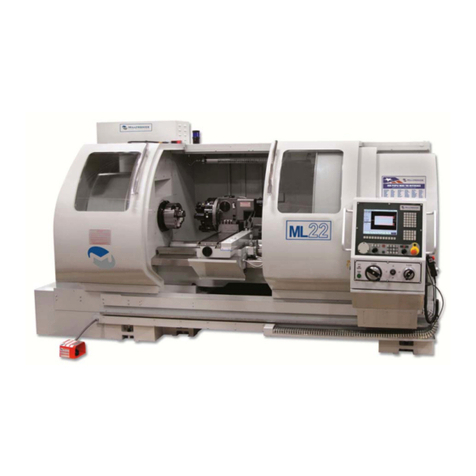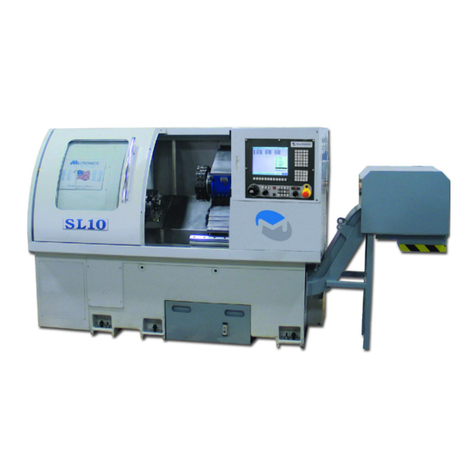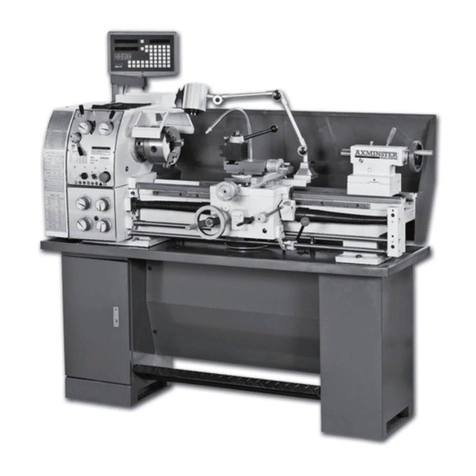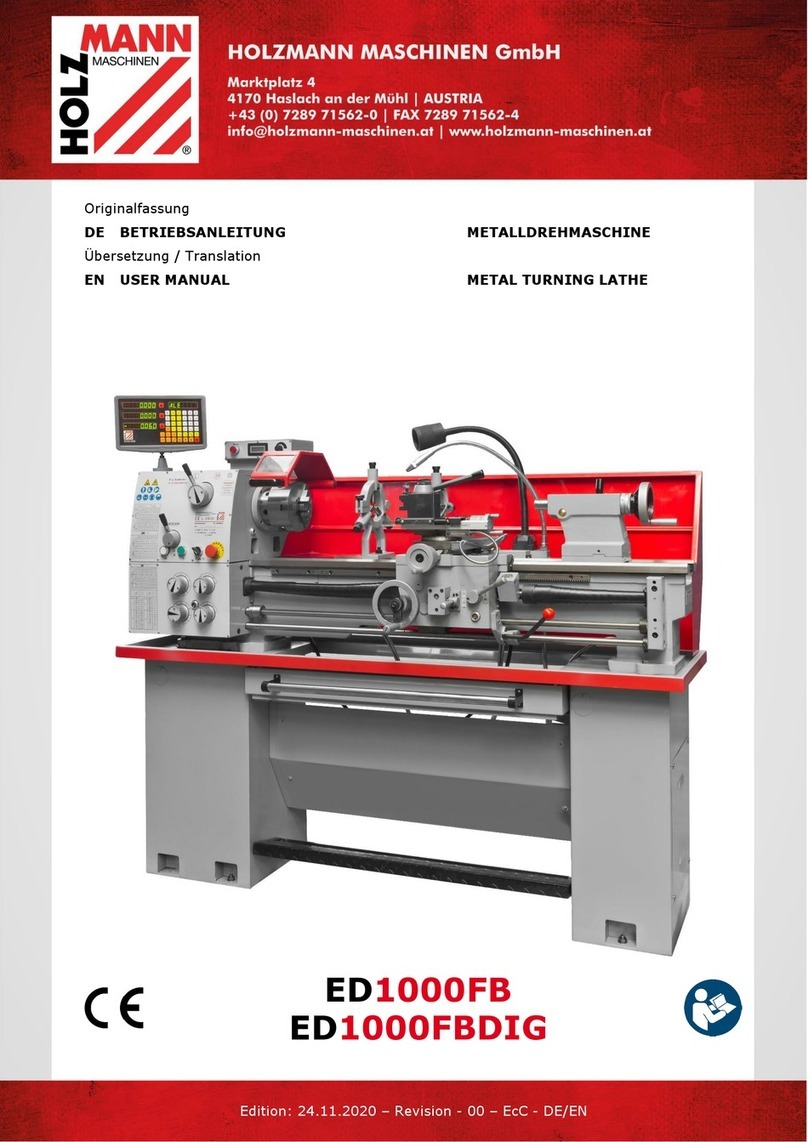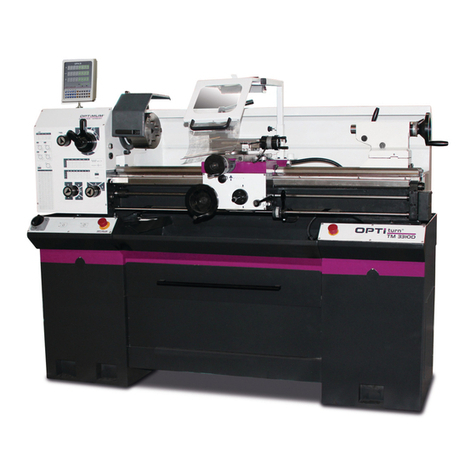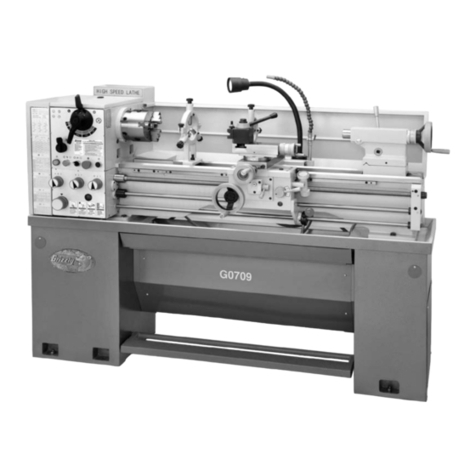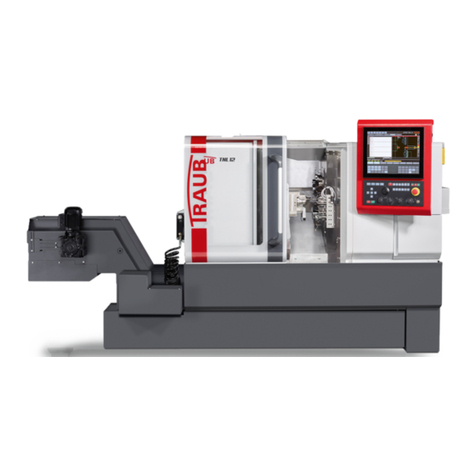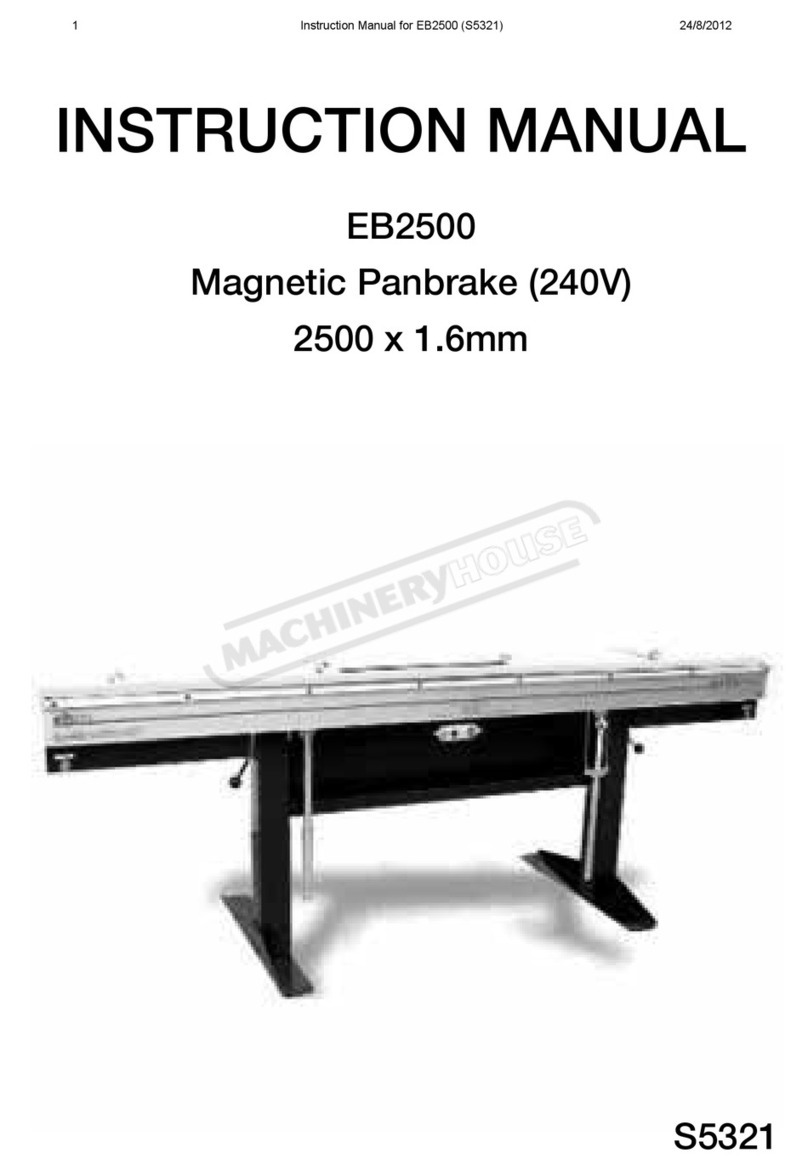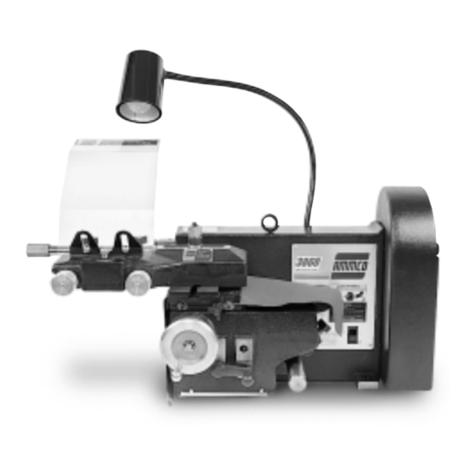RIDGID WL1200 User manual

OWNER’S MANUAL
For Your Safety:
Read all inst ructions carefully
Save this manual for future reference
Part No. SP6169 PrintedinU.S.A.
WL1200
12 INCH
WOOD TURNING LATHE

2
Table of Contents
Table of Contents ........................................................ 2
Safety Instructions For Wood Turning Lathe ............... 3
Safety Signal Words ................................................. 3
Before Using the Lathe ............................................. 3
When Installing Or Moving the Lathe ........................ 3
Before Each Use ....................................................... 3
To Reduce the Risk of Injury From Jams, Slips Or
Thrown Pieces (Kickbacks Or Throwbacks) ............ 4
Plan Ahead To Protect Your Eyes, Hands, Face and
Ears ......................................................................... 4
Inspect Your Workpiece ............................................ 4
Whenever Lathe Is Running ..................................... 5
Before Leaving the Lathe .......................................... 5
Motor Specifications and Electrical Requirements ...... 5
Connecting to Power Source Outlet .......................... 5
Wire Sizes ................................................................. 6
Check Motor Rotation ............................................... 6
Unpacking and Checking Contents ............................. 6
Tools Needed ............................................................ 6
Unpacking ................................................................. 6
List of Loose Parts .................................................... 7
Assembly ..................................................................... 8
Assembling Steel Legset .......................................... 8
Holes Used for Mounting Boards and Wood Lathe to
Leg Set .................................................................... 9
Mounting Left Side Table Top ................................... 9
Mounting Right Side Table Top .............................. 10
Mounting Headstock ............................................... 11
Mounting the Motor ................................................. 12
Headstock,Tailstock, and Tool Rest Assembly ....... 13
Mounting Rear Foot ................................................ 14
Spur and Cup Center Installation ............................ 15
Check Spindle Rotation .......................................... 16
Aligning Centers ...................................................... 16
Adjusting Tailstock .................................................. 16
Getting To Know Your Wood Lathe ........................... 17
On-off Switch .......................................................... 18
Speed Chart .............................................................18
Basic Lathe Operations ..............................................19
Changing Speeds ....................................................19
Spindle Turning ........................................................20
Indexing ...................................................................21
How To Use Your RIDGID Wood Lathe .....................22
Woodworking Chisels and How to Use Them .........22
The Six Commonly Used Chisel Types ...................22
Selection Of Chisels ................................................22
Theory Of Turning ....................................................22
Using The Gouge .....................................................24
Using The Skew .......................................................24
Using The Parting Tool ............................................25
Using The Scraping Chisels ....................................25
Using Shaper Or Moulding Knives ...........................25
Using Wood Rasps And Files ..................................26
Hand Positions .........................................................26
Making Standard Cuts .............................................27
How To Handle Spindle Turnings ............................30
Duplicate Turnings ...................................................31
Long Spindles ..........................................................32
Use Of Backsticks (Not provided) ............................32
Miscellaneous Operations .......................................33
Faceplate & Chuck Turnings ...................................33
How To Make Fancy Faceplate Turnings ................34
How to Turn Plastics ................................................38
Sanding, Buffing And Polishing ...............................39
Wiring Diagram ...........................................................41
Maintenance ...............................................................41
Maintenance ............................................................41
Lubrication ...............................................................41
Troubleshooting ..........................................................42
General ....................................................................42
Motor ........................................................................43
Motor Connections .....................................................44
Repair Parts ...............................................................45
Notes ..........................................................................50

3
Safety Instructions For Wood Turning Lathe
Safety is a combination of common sense, staying alert and knowing how your lathe works. Read this manual to under-
stand this tool.
Safety Signal Words
DANGER: means if the safety information is not followed
someone will be seriously injured or killed.
WARNING: means if the safety information is not followed
someone could be seriously injured or killed.
CAUTION: means if the safety information is not followed
someone may be injured.
Before Using the Lathe
WARNING: Some dust created by power sanding,
sawing, grinding, drilling, and other construction
activities contains chemicals known (to the State
of California) to cause cancer, birth defects or
other reproductive harm. Some examples of these
chemicals are:
• Lead from lead-bases paints,
• Crystalline silica from bricks and cement and
other masonry products, and
• Arsenic and chromium from chemically-treated
lumber.
Your risk from these exposures varies, depending
on how often you do this type of work. To reduce
your exposure to these chemicals: work in a well
ventilated area, and work with approved safety
equipment, such as those dust masks that are spe-
cially designed to filter out microscopic particles.
WARNING: To reduce the risk of mistakes that
could cause serious, permanent injury, do not plug
the lathe in until the following steps have been sat-
isfactorily completed.
Know and Understand the Lathe
• Completely assemble and align lathe.
• Learn the use and function of the ON-OFF switch.
• Review and understand all safety instructions and
operating procedures in this manual.
• Review the maintenance methods for this lathe.
• Find and read the warning label found on the lathe
(shown below).
When Installing Or Moving the Lathe
Reduce the Risk of Dangerous Environment.
• Use the lathe in a dry, indoor place protected from rain.
• Keep work area well lighted.
To reduce the risk of injury from unexpected lathe
movement.
• The lathe and motor must be bolted down to a stand or
workbench for stability.
• To reduce the risk of injury from electrical shock, make
sure your fingers do not touch the plug’s metal prongs
when plugging in or unplugging the lathe.
• Turn off and unplug the lathe before moving it to a new
area. To reduce the risk of back injury, get help when
you need to lift or move the lathe.
•Never Stand On Tool. Serious injury could occur if the
tool tips or you accidentally hit the cutter head. Do not
store anything above or near the tool where anyone
might stand on the tool to reach them.
Before Each Use
Inspect your lathe.
• To reduce the risk of injury from accidental starting, turn
the switch off, unplug the lathe, and remove the switch
key before changing the speeds, changing the setup, or
adjusting anything.
• Check for alignment of moving parts, binding of moving
parts, breakage of parts, unit stability, and any other con-
ditions that may affect the way the lathe works.
• If any part is missing, bent or broken in any way, or any
electrical part does not work properly, turn the lathe off
and unplug the lathe.
• Replace damaged, missing or failed parts before using
the lathe again.
• Keep lathe interior free of wood chips and dust buildup
around motor and switch box.
• Keep turning tools sharp. Dull or nicked tools tend to
dig in the wood, causing the tool or workpiece to be
thrown.
• To reduce the risk of injury from unsafe accessories,
use only recommended accessories.

4
Safety Instructions For Wood Turning Lathe (continued)
Use Recommended Accessories.
• To avoid injury from unsafe accessories, use only rec-
ommended accessories.
• Consult the owners manual for recommended accessories.
• Follow the instructions that accompany the accessories.
WARNING: Use only accessories recommended for
this lathe. (Using other accessories may be danger-
ous.)
To Reduce the Risk of Injury From Jams, Slips Or Thrown Pieces (Kickbacks Or Throwbacks)
When turning between centers or on the faceplate:
- Always rough-out "out of round" workpieces at slow
speed.
- Running the lathe too fast, so that it vibrates, could
cause the workpiece to be thrown from the lathe... or
the turning tool to be jerked from your hands.
Always revolve the workpiece by hand before turning on
the motor. If the workpiece strikes the tool rest, it could
split and be thrown out of the lathe.
Do not allow the turning tool to "bite" into the workpiece
which could result in splitting of the workpiece or the work-
piece being thrown from the lathe.
- Always position the tool rest above the centerline of
the lathe for spindle turning.
- Do not apply the turning tool to the workpiece below
the level of the tool rest.
Do not run the lathe in the wrong direction. This could
cause the turning tool to be thrown from your hands. The
lathe must run in a direction so that the top of the work-
piece turns toward you.
Before attaching a workpiece to the faceplate:
- Always "rough it out" to as "true round" as possible.
This will minimize vibration while turning.
- Always fasten the workpiece securely to the face-
plate.
- Failure to perform these set-up operations could
cause the workpiece to be thrown from the lathe.
Avoid awkward hand positions, where a sudden slip could
cause a hand to move into the workpiece.
Remove all loose knots before installing workpiece be-
tween centers or on the faceplate.
Never leave the lathe work area with the power on, before
the lathe has come to a complete stop, or without remov-
ing and storing the switch key.
Never operate the lathe with protective cover on the un-
used shaft end of the motor removed.
Hang your turning tools on the wall toward the tailstock
end of the lathe. Do not lay them on the bench so that you
must reach over the revolving workpiece to select them.
Keep firm hold and control of the turning tool at all times.
Special caution must be exercised when knots or voids
are exposed to the turning tool.
Plan Ahead To Protect Your Eyes, Hands, Face and Ears
Reduce the Risk of Accidental Starting.
• Make sure switch is “OFF” before plugging lathe into a
power outlet.
Dress for safety.
• Any power tool can throw foreign objects into the eyes.
This can result in permanent eye damage. Always
wear safety goggles, not glasses complying with ANSI
Z87.1 (or in Canada CSA Z94.3-99) shown on pack-
age. Everyday eyeglasses have only impact resistant
lenses. They are not safety glasses. Safety goggles
are available at many local retail stores. Glasses or
goggles not in compliance with ANSI or CSA could
seriously hurt you when they break.
• For dusty operations, wear a dust mask along with
safety goggles.
• Do not wear loose clothing, gloves, neckties or jewelry
(rings, wrist watches). They can get caught and draw
you into moving parts.
• Wear nonslip footwear.
• Tie back long hair.
• Roll long sleeves above the elbow.
• Noise levels vary widely. To reduce the risk of possible
hearing damage, wear ear plugs or muffs when using
lathe for hours at a time.
Inspect Your Workpiece
• Think Safety.
• Complete hand sanding of between-centers or face-
plate mounted workpieces Before removing from the
lathe. Do not exceed the speed used for the last cutting
operation performed on the workpiece, in accordance
with the speed chart.

5
•Never attempt to remount a faceplate turning to the
faceplate for any reason. Never attempt to remount a
between-centers turning if the original centers in the
turning have been altered or removed. Be positive the
lathe is set at the lowestspeed if remounting a between-
centers turning with non-altered original centers.
• Use extra caution in mounting a between-centers or
spindle turning to the faceplate, or a faceplate turning
to between- centers, for subsequent operations. Be
positive the lathe is set at the lowest speed before
turning ON.
•Never mount a workpiece that contains any splits,
checks, or loose knots to a faceplate or between cen-
ters.
• Do not perform any operation when hand holding the
workpiece. Do not mount a reamer, milling cutter, wire
wheel, buffing wheel, or a drill bit to the headstock
spindle.
Whenever Lathe Is Running
WARNING: Don't allow familiarity (gained from fre-
quent use of your lathe) to cause a careless mis-
take. Always remember that a careless fraction of
a second is enough to cause a severe injury.
• Before actually turning with the lathe, let it run for a
while. If it makes an unfamiliar noise or vibrates a lot,
stop immediately. Turn the lathe off. Unplug the lathe.
Do not restart until finding and correcting the problem.
Keep Children Away.
• Keep all visitors a safe distance from the lathe.
• Make sure bystanders are clear of the lathe and work-
piece.
Don’t Force Tool.
• Feed the tool into the workpiece only fast enough to let
the tool cut without bogging down or binding.
Before freeing jammed material.
•Turnswitch“OFF”.
• Wait for all moving parts to stop.
• Unplug the lathe.
Before Leaving the Lathe
• Turn the lathe off.
• Wait for lathe to come to a complete stop.
• Unplug the lathe.
• Make workshop child-proof. Lock the shop. Disconnect
master switches. Remove the yellow switch key. Store
it away from children and others not qualified to use
the tool.
Motor Specifications and Electrical Requirements
This Lathe is designed to use a 1725 RPM motor only. Do
not use any motor that runs faster than 1725 RPM. It is
wired for operation on 110-120 volts, 60 Hz., alternating
current.
CAUTION: Do not use blower or washing machine
motors or any motor with an automatic reset over-
load protector as their use may be hazardous.
Connecting to Power Source Outlet
This machine must be grounded whilein use to protect the
operator from electric shock.
Plug power cord into a 110-120V properly grounded type
outlet protected by a 15-amp. dual element time delay or
Circuit-Saver fuse or circuit breaker.
If you are not sure that your outlet is properly grounded,
have it checked by a qualified electrician.
WARNING: Do not permit fingers to touch the termi-
nals of plugs when installing or removing the plug
to or from the outlet.
If power cord is worn or cut, or damaged in any way,have
it replaced immediately.
If your unit is for use on less than 150 volts it has a plug
that looks like below.
This power tool is equipped with a 3-conductor cord and
grounding type plug which has a grounding prong,
approved by Underwriters' Laboratories. The ground con-
ductor has a green jacket and is attached to the tool
housing at one end and to the ground prong in the attach-
ment plug at the other end.
This plug requires a mating 3-conductor grounded type
outlet as shown.
If the outlet you are planning to use for this power tool is
of the two prong type Do Not Remove Or Alter The
Grounding Prong In Any Manner. Use an adapter as
shown and always connect the grounding lug to known
ground.
It is recommended that you have a qualified electrician re-
place the two prong outlet with a properly grounded three
prong outlet.
Properly
Grounded
Outlet
3-Prong Plug
Grounding
Prong
Other manuals for WL1200
1
Table of contents
Other RIDGID Lathe manuals
